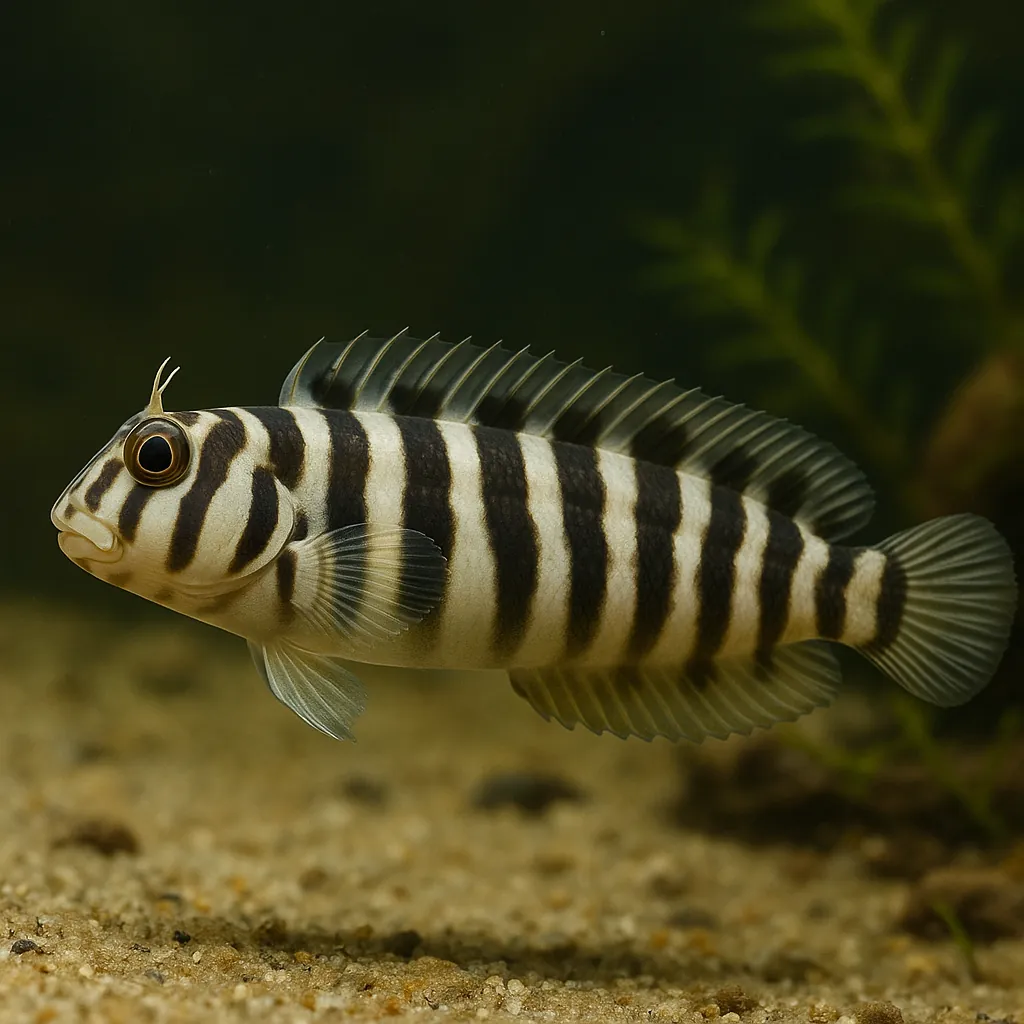
Zebra blenny
Introduction
The Zebra blenny (*Omobranchus zebra*) is a captivating addition to brackish aquariums, renowned for its striking black and white stripes that resemble a zebra's pattern. This small fish, reaching up to 6 cm in length, is appreciated by aquarists for its unique appearance and active behavior. While they can be territorial, with proper care and tank setup, Zebra blennies can thrive and become a focal point in a brackish water community.What makes the Zebra blenny a popular choice among aquarists?
Their distinctive striped pattern and lively nature make them an attractive and engaging species for brackish water tanks.
Are Zebra blennies suitable for beginner fishkeepers?
Due to their specific habitat requirements and territorial behavior, they are better suited for aquarists with some experience in maintaining brackish water environments.
Care and Environment
Proper care for the Zebra blenny involves replicating its natural brackish habitat and addressing its behavioral traits. **Tank Size and Setup** A minimum tank size of 75 liters is recommended to provide ample space and reduce territorial disputes. In larger tanks, multiple hiding spots can help manage aggression. **Water Parameters** - **Salinity:** Maintain a specific gravity between 1.005 and 1.015 to replicate brackish conditions. - **Temperature:** Keep the water temperature between 20°C and 28°C. - **pH Level:** Aim for a pH range of 7.5 to 8.7. - **Hardness:** Maintain water hardness between 17 and 30°N (303.57 - 535.71 ppm). **Filtration and Lighting** Use gentle filtration to ensure clean water without creating strong currents, as Zebra blennies prefer calmer waters. Standard aquarium lighting is sufficient, but providing shaded areas with floating plants or decorations can help mimic their natural environment. **Feeding Needs** Zebra blennies are opportunistic feeders that thrive on a varied diet. Offer live or frozen foods such as bloodworms, brine shrimp, and copepods. High-quality sinking pellets or algae wafers can supplement their nutrition. Feed them small portions 2-3 times daily to mimic their natural foraging behavior. **Tank Decor and Substrate** A sandy substrate is ideal to accommodate their substrate-sifting behavior. Incorporate rock formations, bogwood, and other decorations to create caves and hiding spots. Floating plants or mangrove roots can provide shaded areas and enhance the tank's aesthetics. **Specific Challenges** Zebra blennies can be territorial and may exhibit aggression toward similar-looking species or those occupying the same tank levels. Providing ample hiding spots and visual barriers can help reduce territorial disputes. Regular water changes are essential to maintain optimal water quality and prevent stress-related issues.Can Zebra blennies be kept in freshwater tanks?
No, they require brackish water conditions to thrive and should not be kept in freshwater setups.
How can I reduce aggression among Zebra blennies?
Providing a larger tank with multiple hiding spots and visual barriers can help manage territorial behavior.
Origin and Habitat
*Omobranchus zebra* is native to South Asia, commonly inhabiting brackish waters such as estuaries and mangrove swamps. These environments are characterized by varying salinity levels, sandy substrates, and abundant hiding spots among roots and submerged vegetation. The natural habitat's calm waters and rich biodiversity provide ample feeding opportunities and shelter, which should be replicated in captivity to ensure the well-being of Zebra blennies.Where can Zebra blennies be found in the wild?
They are native to South Asia, inhabiting brackish waters like estuaries and mangrove swamps.
What type of environment do Zebra blennies prefer?
They thrive in calm, brackish waters with sandy substrates and abundant hiding spots among roots and submerged vegetation.
Temperament and Compatibility
Zebra blennies are known for their territorial and aggressive behavior, especially toward similar-looking species or those occupying the same tank levels. They are best housed with larger, peaceful brackish species that prefer mid to upper tank levels, such as Mono Sebae or Figure-Eight Puffers. Avoid keeping them with small or slow-moving species that may become targets of aggression. Providing ample hiding spots and visual barriers can help reduce territorial disputes.Are Zebra blennies suitable for community tanks?
They can be kept in community tanks with careful selection of tank mates that occupy different tank levels and are not similar in appearance.
How can I prevent aggression in my Zebra blenny?
Providing a larger tank with multiple hiding spots and choosing appropriate tank mates can help manage their territorial behavior.
Interesting Facts
- Zebra blennies are adept jumpers and can leap out of the water to escape predators, so a secure tank lid is essential. - They have a unique ability to change their coloration slightly to blend with their surroundings, aiding in camouflage. - In the wild, male Zebra blennies guard the nest site and aerate the eggs until they hatch, showcasing their parental care.Do Zebra blennies exhibit any unique behaviors?
Yes, they are known for their jumping ability and can change coloration to blend with their surroundings.
How do Zebra blennies reproduce?
Males guard the nest site and aerate the eggs until they hatch, demonstrating notable parental care.
Sources
All information in this article has been gathered from the following reputable sources:
Overview
Recommended Tank Size 39.6 Gallons (for a pair with ample hiding spots) |
Minimum Group Size 1 |
Minimum Tank Volume 19.8 Gallons |
Maximum Adult Length 2.4 inches |
Average Adult Length 2 inches |
Shoaling (6+ required) No |
Preferred Water Type Brackish |
Temperature Range (°C) 20–28 |
pH Range 7.5–8.7 |
Water Hardness (dGH) 17–30 |
Typical Lifespan (years) 3 years |